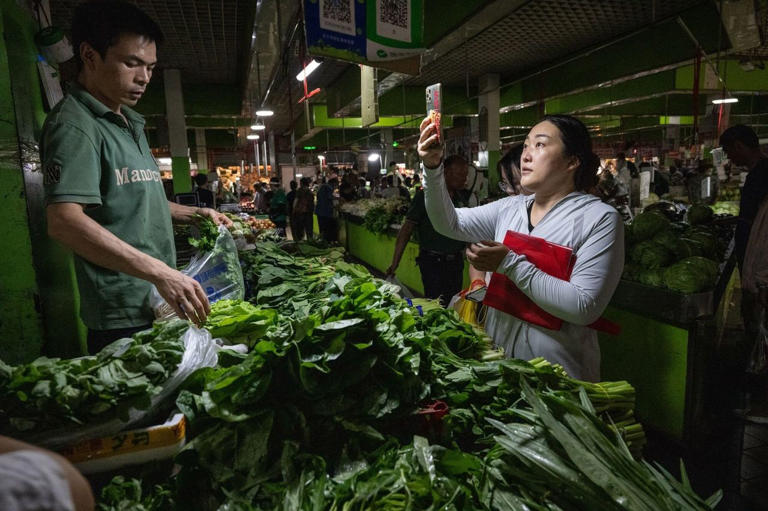China’s recent inflation data offers a nuanced view of the country’s economic situation, revealing both signs of cautious optimism and underlying challenges. According to the National Bureau of Statistics, the consumer price index (CPI) rose by 0.5% year-over-year in July. This increase marks a five-month high and exceeds the 0.4% rise forecasted by economists surveyed in a Wall Street Journal poll. This uptick represents the sixth consecutive month of rising consumer prices and provides a tentative sign of progress for policymakers who have been striving to invigorate household spending and stimulate economic growth.
Consumer Inflation Trends
The July CPI increase, although modest, reflects a slight improvement in the inflationary landscape. This rise contrasts with June’s 0.2% increase and suggests a gradual upward trend in consumer prices. The primary driver behind this inflationary movement is food prices, particularly pork, which saw a substantial year-over-year increase. This marks a reversal from 12 months of deflation in food prices, highlighting a significant shift in the inflationary dynamics of essential goods.
Economist Lynn Song from ING notes that current conditions suggest a potential for inflation to trend higher in the coming months. Prices for non-food items also contributed to inflation, rising by 0.7% in July, although this represents a slight decrease from the 0.8% rise recorded in June. Core consumer inflation, which excludes more volatile categories such as food and energy, increased by 0.4% in July, down from the 0.6% growth observed in June. This indicates that while there is some inflationary pressure, it remains relatively subdued and may not be sufficient to substantially impact the broader economic environment without additional policy interventions.
Producer Price Index and Economic Pressures
In contrast to consumer inflation, the producer price index (PPI) remained in deflationary territory. The PPI fell by 0.8% in July from the previous year, marking the 22nd consecutive month of contraction. This decline aligns with the anticipated 0.9% decrease and underscores ongoing challenges within China’s manufacturing sector. Excess industrial capacity and tepid consumer demand contribute to these deflationary pressures, reflecting a broader trend of economic uncertainty and subdued pricing power in the industrial sector.
Policy Responses and Economic Outlook
The modest improvement in consumer inflation does not fully address the broader economic issues facing China. Economists emphasize the need for more robust policy measures to stimulate the property sector and boost household consumption. The property market, a traditional store of wealth for many Chinese households, remains under significant strain. Recent data reveals a continued decline in home sales and a slower-than-expected recovery in the property sector, which has implications for overall economic stability and consumer confidence.
Nomura economists argue that Beijing must adopt more aggressive actions to address the ongoing housing crisis and stimulate consumer spending. The limited impact of current measures, including incremental fiscal support, suggests that more direct and substantial interventions may be required to rejuvenate economic activity and restore consumer confidence.
Monetary Policy and Fiscal Measures
In response to economic challenges, China’s central bank has implemented interest rate cuts to support growth. However, these efforts are balanced by concerns over currency stability and the impact on bank profit margins. As a result, there is a growing expectation that fiscal policy will need to play a more prominent role in driving economic stimulus. ING’s Lynn Song anticipates at least one more rate cut this year, with the potential for additional reductions if global economic conditions prompt further rate adjustments.
Despite the central bank’s monetary easing efforts, there is ongoing debate about the adequacy of these measures. Authorities have rejected a substantial property rescue plan proposed by the International Monetary Fund (IMF), which suggested deploying $1 trillion in central government funds. Beijing’s rejection of this plan underscores its reluctance to set a precedent for government bailouts and highlights the complex balance between stimulating growth and managing fiscal and economic risks.
Conclusion
China’s recent inflation data provides a mixed picture of the country’s economic health. While there are signs of gradual improvement in consumer inflation, significant challenges remain, particularly in the property sector and manufacturing industry. Policymakers face the task of navigating these complexities to ensure sustainable economic recovery and stability. The need for more comprehensive policy responses and fiscal measures is evident, as the current incremental approaches may not be sufficient to address the broader economic challenges.
